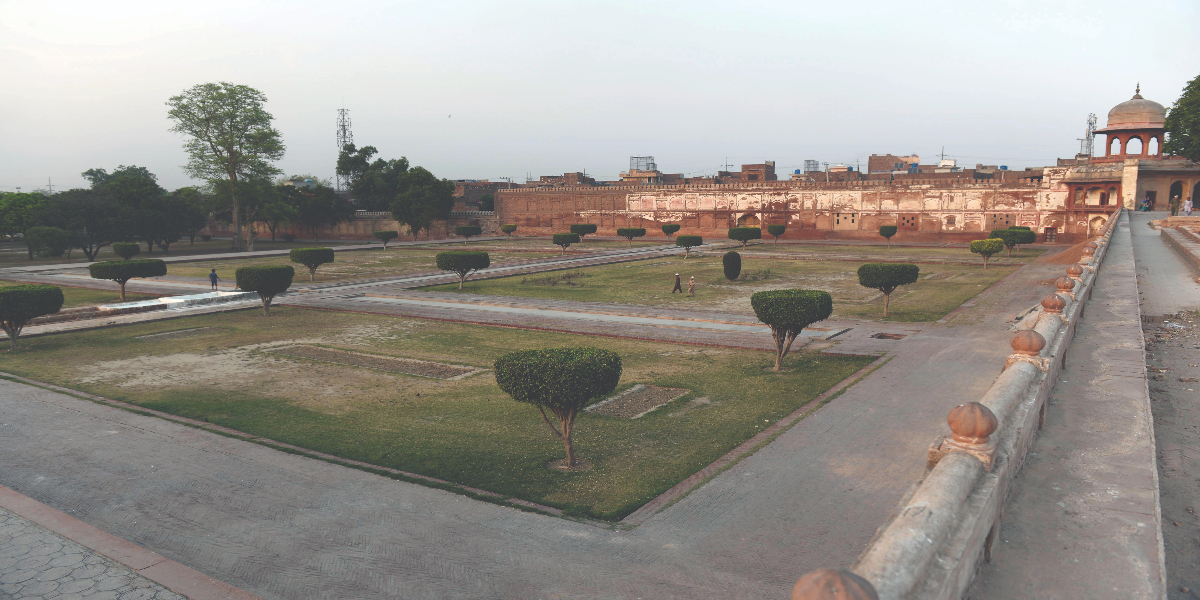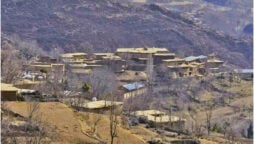
Photos: Mohsin Raza/Bol News
Built by Emperor Shah Jahan, the iconic Shalimar Gardens ‘revived’ by Punjab is expected to see a growth in heritage tourism
The Shalimar Gardens lays out as a royal, pleasure garden in the walled city of Lahore. It was built at the command of Emperor Shah Jahan and expresses the pure, aesthetic taste of Mughal landscape architecture.
The heritage site has been visited by hundreds of thousands of history lovers from across the country and other parts of the world.
To encourage more visitors and to upgrade the public facilities and illuminate the site, the provincial government, considering the sensitivity of the cultural issue, had approved an ADP scheme titled ‘Upgradation of Public Facilities and Illumination of Important Heritage Monuments/Sites of Punjab’.
This scheme was initiated in 2021 to provide tourist facilities like benches, canopies and dustbins at various heritage sites including Shalimar Gardens.
Most of the work has been executed on all the major components of the scheme, according to the Directorate General of Archaeology Punjab.

Photos: Mohsin Raza/Bol News
Preservation and restoration of structures inside Shalimar Gardens like Aramgha Shahjahni, Corner Towers, Khawab Gah Building, Moor Craft Building, Water channels/Tank, Walkways, Middle Terrace Dividing wall have been completed.
A major component of land acquisition is yet to be done after carrying out proper study which is reportedly underway.
The benches and dustbins and drinking water facilities have been provided in Shalimar Gardens without any addition. Under the same project architectural illumination of prominent structures and the southern perimetre wall has also been done to promote the heritage tourism in the country.
The Shalimar Gardens, laid out in three terraces, descending from south to north, covering an area of 16 hectares, are surrounded by a high wall with serrated battlements. The corners at the end of terraces are occupied by Burj. The inner of the wall is relieved with cusped arched panels of varying sizes. Originally, the gardens were entered through two elegant gateways, pierced in the eastern and the western walls of the Lowest Terrace. The terraces of the Shalimar Gardens were named after the plantation, which flourished in them.
The upper terrace named Farah Bakhsh has only flowers and sweet-scented shrubs planted. This terrace was purely for Haram-e-Shahi (the royal princes and ladies).
The middle terrace named Faiz Bakhsh has fruit trees planted. On both these terraces, flower plants of every season were grown.
The lowest terrace was Hayat Bakhsh; on this terrace, the fruit and shady trees were planted.
All the three have the same area, the symmetrical gardens’ plots are divided by intersecting canals into foursquare parterres. The raised brick walkways were also constructed. The iconic gardens embody the Mughal concept of a ‘perfect garden’. It is an enclosed area divided into symmetrical parterres of turf, containing murmuring waters of canals, and calm mirrored singing cascades, swaying cypresses, bushes of roses, misty spray of the fountains drifting in the open fronted summer pavilions, shady deliciously cool and a pleasant atmosphere.
Reportedly, the World Heritage Site has been visited by more than a million tourists from homeland and abroad. History has shown that wherever the Mughals went, they established magnificent gardens and edifices for their entertainment and relaxation wherever they liked. Shalimar Gardens is a prime example of this Mughal cultural and architectural sophistication. The historic gardens were made on the orders of Emperor Shah Jahan and the construction of these eye-refreshing gardens began in 1641. The completion year was 1642.
In order to leave their mark in history, every Mughal emperor built something unique so that their makers are remembered for their beautiful and unique buildings. During Shah Jahan reign Mughal architecture was at its artistic and ornamental peak. After the conclusion of the Mughal Empire these buildings were captured by many rulers as a result of rift for power among local rulers and the entry of the British in the Subcontinent. The splendor of magnificent monuments like Shalimar Gardens were badly affected. Moreover, over the course of time the condition of these spectacular monuments became detrimental because of negligence. The restoration and conservation of these magnificent monuments’ responsibilities falls within the jurisdiction of Directorate General of Archaeology Punjab.

Photos: Mohsin Raza/Bol News
To learn more about the progress on the work being done on the heritage site, Bol News reached out to the Archaeology Director Maqsood Ahmad to get to know what efforts have been made so far and what restoration projects are in the pipeline for the protection and conservation of this marvel Shalimar Gardens.
According to the documents shared with Bol News by the Directorate General of Archaeology Punjab, there were two other Mughal gardens, known as Shalimar, one at Srinagar, and the other at Delhi; while the one at Srinagar still survives, that at Delhi has completely disappeared.
Aptly called the ‘Versailles of Punjab’, the gardens tell the story of how ‘nature and man have combined to make them lovely, while history and legend have woven much romance.’
Due to its universal value the Shalimar Gardens has been declared a World Heritage cultural site by UNESCO in 1981.
It was constructed by the Mughal emperor’s noble Khalilullah Khan in a very short time of one year. The foundations of the gardens were laid on July 12, 1641 and completed on October 31, 1642.
To irrigate the Shalimar Gardens a canal named Shah Nahar (royal canal) was dug from the River Ravi at Rajpur (Madhopur), 100 miles in the north east of Lahore.
The meaning of Shalimar has been variously interpreted, most popularly of all as ‘adobe of bliss’ or ‘light of the moon.’ The most possible interpretation, however, seems to be that the word Shalimar is a corruption of original Shalimar, composed of Shali (rice paddy) and Mar (black loamy soil), in the Kashmiri language. Shalimar, therefore, meant ‘black loamy soil for growing paddy.’ In any case, the first Mughal gardens, bearing the name ‘Shalimar’ were laid out in Kashmir, and may have derived its name from Kashmiri language.
A wonderful system was adopted to provide water in the Shalimar Gardens. Ali Mardan Khan, a Persian noble and Governor of Lahore, sought permission of Emperor Shahjahan to build a canal (Shah Nahar or Royal Canal) with the help of Mulla Ala’ul Mulk Tuni, an expert in hydrology. There was a perfect system of irrigation for the Shalimar Gardens. Shalimar Gardens suffered ‘heavy losses’ during the Sikh and British periods. Although, present Shalimar Gardens are those, constructed by Mughals but kinds of plantation is not that time.

Photos: Mohsin Raza/Bol News
The Shalimar Gardens is one of the most important monuments in Pakistan and it was inscribed on the World Heritage List of UNESCO in 1981. The buildings represent the timeline from Emperor Shah Jahan’s era to the British colonisation period.
The Government of the Punjab approved a major conservation plan for preservation and restoration of Shalimar Gardens in 2006-2007 amounting to Rs290.59 million and works for preservation and restoration of various areas of the gardens are continuous since then.
Different parts of the Shalimar Gardens have sufficiently been conserved, restored and stabilized to avoid further decay. Major Components of the project are Preservation and Restoration of Summer Pavilion, Aramgah Shahjahan, Khwabgah building, corner towers, old well and hydraulic structure, perimeter wall, walkways, moor craft building, water channels, dividing wall of first and 2nd terrace, procurement of red sandstone (Indian), land acquisition around Shalimar Gardens for buffer zone, drainage system on exterior of the gardens and petty urgent works.
The shared documents further stated that the Punjab government ‘is also fully committed’ to implement the recommendations of the World Heritage Committee. In this regard, a PC-II titled “Studies to Implement the Recommendations of Joint Reactive Monitoring Mission of UNESCO & ICOMOS for Shalimar Gardens, Lahore” was approved by the competent forum amounting to Rs48.3 million to conduct several studies related to the Gardens such as Traffic Feasibility Study, Environmental Studies, Socio-Economic Baseline Studies, Buffer Zone Management Study, Conservation Study, Visitor Management Study, Stakeholder Engagement Study and Compliance Study. The outcome of these studies and recommendations of consultants will be shared with the World Heritage Centre in line with Paragraph 172 of the Operational Guidelines, for their review and comments of the Advisory Bodies prior to their implementation.
The encroachments and urban development around the monument in the buffer zone are being monitored and controlled with the help of concerned authorities. A Regulatory Committee has already been notified for future projects in compliance with the provisions of the Operational Guidelines of UNESCO.
Horticulture renovation
For improvement of lawns of the World Heritage Site of Shalimar Gardens in its traditional landscape a plan has been initiated. It includes the revival of historical landscaping of monuments and provision of necessary tools required for maintenance of Gardens. The irrigation system to irrigate the lawns is also being improved. To revive the traditional landscape of the gardens, a study through a renowned expert has been conducted and horticulture work is being carried out as per plan. The scope of the work includes improvement of horticulture work of the lawn area and rehabilitation of irrigation work.
Catch all the Breaking News Event and Latest News Updates on The BOL News
Download The BOL News App to get the Daily News Update & Live News.












 Read the complete story text.
Read the complete story text. Listen to audio of the story.
Listen to audio of the story.